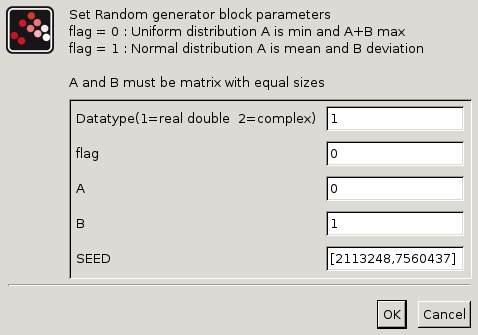

The original signal we want to sample is x(t). Let us investigate what happens if the sampling rate is too low. The memory allocated for data process may be limited. But for embedded control applications, resources are expensive.
Scilab constant Pc#
In a modern desktop PC this does not sound like a problem. The more frequent the sampling, the more data we have to keep. How often should we sample the signal x(t)? Common sense tells us the more frequent, the better, since it is obvious from Figure 6 if the samples x are close together, they should represent x(t) very well. (In some areas of engineering such as communication systems, multi-rate sampling may exist, but for digital control applications there is no use for such complicated schemes.)Ī question follows naturally. The signal x(t) is sampled at fixed time interval Δ, called the sampling period. So, as shown in Figure 2, the continuous signal x(t) has to be sampled into a sequence x, where integer k is the index, or the relative address of data to be selected by the pointer.

At one moment in time, a value to be processed is addressed by a data pointer. While a real world signal is continuous, a computer works with values stored in a bank of memory. Before we get into that, an important issue must be addressed. It is described either by difference equations, or by a Z- transfer function. For some motor amplifier that receives a PWM (Pulse-Width-Modulation) input, the PWM unit then replaces the DAC. For instance, motion control applications usually get feedback from motor encoders, which are digital in nature. Note that Figure 1 shows a basic configuration. Nevertheless, it is not difficult to find an external DAC chip with easy interface. Most modern microcontrollers have built-in ADC units, but those with internal DAC’s are rare. The block labeled DAC (Digital-to-Analog Converter) and ADC (Analog-to-Digital Converter) are commonly-used to serve this purpose. To connect them together, we need additional components to convert the signals from one form to another. Now we have two domains separated by the vertical dotted line i.e., the controller side is discrete, and the plant side is continuous. So the continuous-time feedback diagram in needs to be changed to a hybrid form in Figure 1.
Scilab constant how to#
Scilab constant code#
As a special service "Fossies" has tried to format the requested source page into HTML format using (guessed) C and C++ source code syntax highlighting (style: standard) with prefixed line numbers and code folding option.Īlternatively you can here view or download the uninterpreted source code file.įor more information about "constexp.hxx" see the Fossies "Dox" file reference documentation.ġ /* 2 * Scilab ( ) - This file is part of Scilab 3 * Copyright (C) 2007-2008 - DIGITEO - Bruno JOFRET 4 * 5 * Copyright (C) 2012 - 2016 - Scilab Enterprises 6 * 7 * This file is hereby licensed under the terms of the GNU GPL v2.0, 8 * pursuant to article 5.3.4 of the CeCILL v.2.1.


 0 kommentar(er)
0 kommentar(er)
